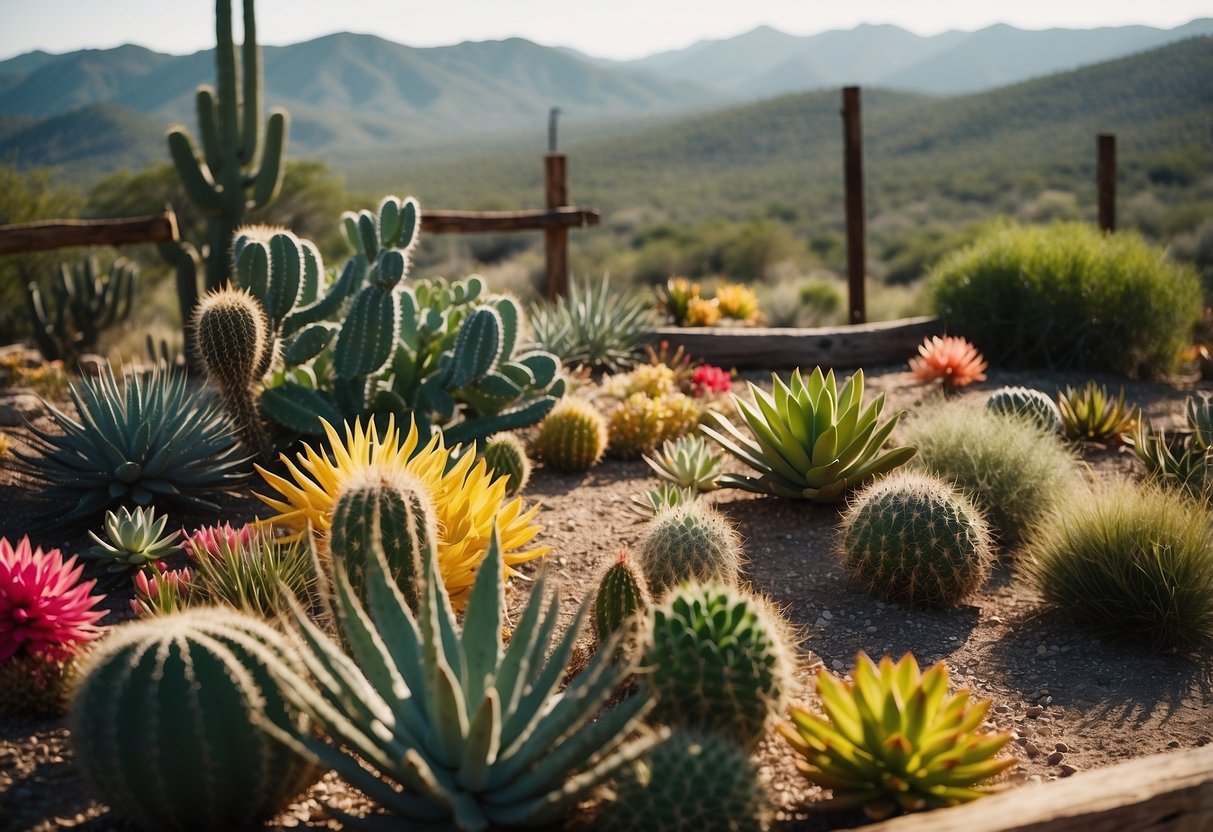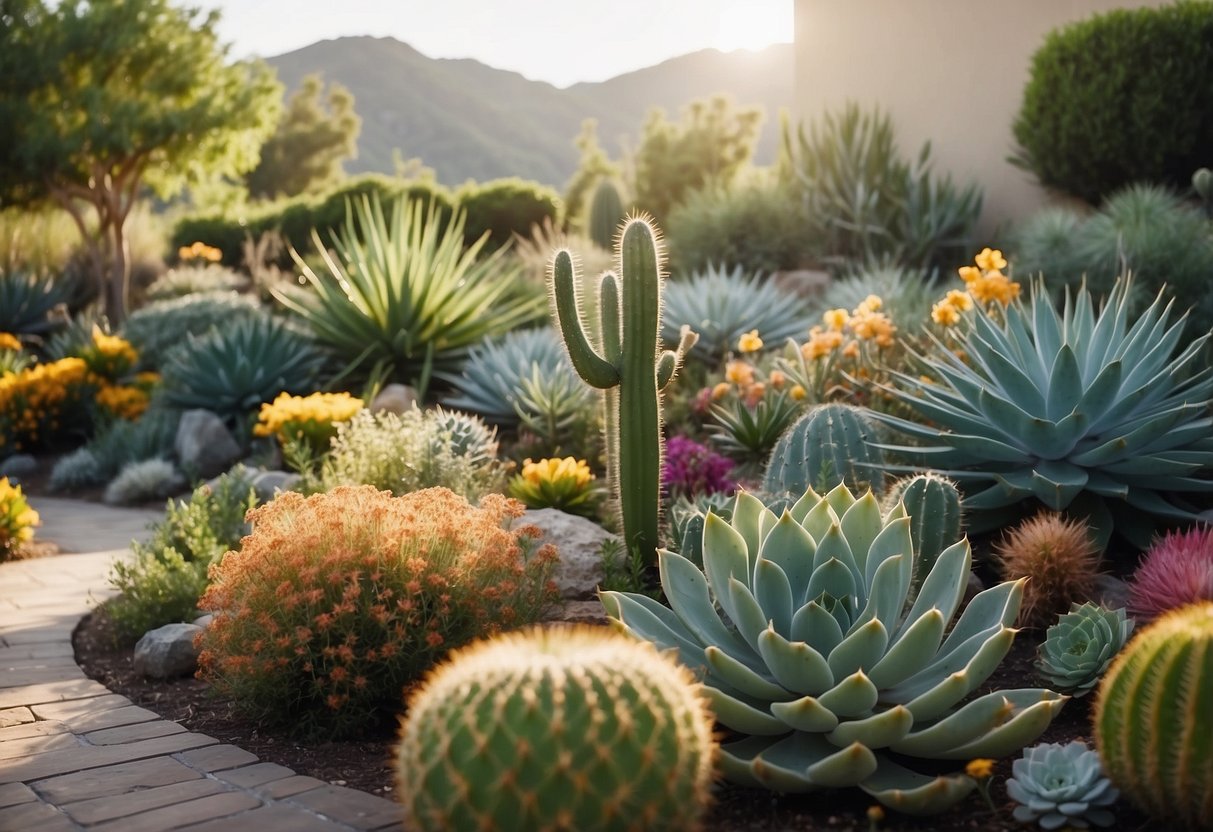South Texas Garden Ideas: Creative Tips for a Vibrant Outdoor Space
Welcome to the world of South Texas gardening! South Texas offers a unique climate that can be both challenging and rewarding for gardeners. With the right plants and techniques, your garden can thrive despite the hot and dry conditions.

What are the best ways to create a flourishing garden in South Texas? From choosing native plants to utilizing water-conserving methods, you’ll find that a beautiful and vibrant garden is possible even in the toughest weather. Get ready to discover tips and ideas to transform your outdoor space into a stunning oasis.
1) Bluebonnets

Bluebonnets are a great choice for your South Texas garden. They thrive in full sun, needing 8-10 hours of direct sunlight each day. If you have a hot, sunny spot, bluebonnets will do very well.
Bluebonnets prefer well-drained, alkaline soil with moderate fertility. A good tip is to cover the seeds with soil about a quarter inch deep after planting.
Neglecting bluebonnets is actually beneficial. They don’t need much watering once they’re established. Just water them when the top inch of the soil feels dry. It’s that easy!
For more detailed tips, check out this guide.
2) Prickly Pear Cactus

The prickly pear cactus is a great choice for your South Texas garden. It thrives in the hot, arid climate and requires very little water.
You can find varieties like the Texas prickly pear cactus growing along roadsides and rocky areas. This makes it perfect for adding a touch of local flavor to your garden.
For containers, consider the tiny, very prickly Bunny Ears variety. If you prefer a more dramatic look, the Texas blue prickly pear can grow up to eight feet tall with beautiful blue pads.
3) Mexican Feather Grass

Mexican Feather Grass is a great choice for your South Texas garden. It adds a soft, flowing touch to your landscape.
This grass grows best in areas with full sun to partial shade. It needs at least six hours of sunlight each day. Make sure to plant it in well-draining soil to avoid root rot.
In warmer months, it may lose some color. However, it thrives in winter, enduring temperatures as low as 0 degrees Fahrenheit. It’s also easy to divide and replant for more coverage in your garden.
4) Coral Honeysuckle

Coral honeysuckle is a great choice for your South Texas garden. This plant brings a splash of color with its red, coral, orange, or yellow trumpet-shaped flowers. You’ll love how it attracts hummingbirds and butterflies to your garden.
This vine is native to the southeast United States, making it a strong, non-invasive option. It can grow well in loamy soil with good drainage.
5) Texas Sage

Texas Sage is a wonderful choice for your South Texas garden. This hardy shrub, also known as Cenizo, thrives in arid and semi-arid regions, making it perfect for hot, dry climates.
The plant has beautiful gray-green leaves and produces vibrant purple blooms after rain, earning it the nickname “Barometer Bush.”
It’s low-maintenance. You just need to water it when the top couple of inches of soil are dry. Get more details on growing Texas Sage here.
6) Turk’s Cap

Turk’s Cap is a great addition to your South Texas garden. The plant stands out with its bright red or pink hibiscus-like flowers, which attract hummingbirds and butterflies.
The shrub can grow 4 to 6 feet tall and is completely winter-hardy across Texas. It thrives best in morning sun and afternoon shade.
Planting Turk’s Cap means you will enjoy flowers from late spring through fall. The plant can handle full sun or part shade and adapts well to different soil types. It’s perfect for adding color and life to your garden.
Learn more about Turk’s Cap care.
7) Lantana

Lantana is a great addition to your South Texas garden. It loves heat and thrives with little water, making it perfect for the Texas climate. Plant it in full sun for best results.
Lantana attracts butterflies and bees with its colorful blooms. You can choose varieties like Texas Flame and Samantha. These plants will bloom all summer long.
Be sure to water deeply when planting and mulch around the base to retain moisture. Enjoy the vibrant colors and the pollinators they bring to your garden!
8) Esperanza

Esperanza, also known as Tecoma stans or Yellow Bells, is a fantastic addition to your south Texas garden. This plant thrives in high temperatures and blooms through the hottest summer months.
The bright yellow flowers attract pollinators like native American Bumblebees. They also serve as host plants for Dogface butterflies and Sphinx moths.
Planting Esperanza is simple. Dig a hole twice as wide and slightly deeper than its root ball. Place the plant in, level it with the surrounding soil, and water thoroughly. You can find more details here.
9) Red Yucca

Red Yucca is a great choice for your south Texas garden. This plant thrives in full sun and requires very little water, making it perfect for dry conditions.
The plant features tall spikes with showy red or yellow flowers that can reach up to six feet. These blooms attract hummingbirds, adding life to your garden.
Red Yucca is not a true yucca but is closely related to agaves. It’s an evergreen plant with long, slender leaves that stay green year-round. For more details, visit Garden Style San Antonio.
10) Blackfoot Daisy

Blackfoot Daisy is a fantastic addition to your South Texas garden. This plant features creamy-white daisy flowers and narrow, green leaves.
It thrives in full sun or part shade and is ideal for rocky or gravelly soil. You can see it blooming from March to November.
Perfect for xeric gardens, this daisy attracts birds, bees, and butterflies, adding life and color to your garden. Consider planting it along pathways or rocky outcrops for a natural, beautiful look.
Best Plants for South Texas Gardens

Choosing plants that thrive in South Texas can enhance your garden. Focus on drought-resistant plants, native Texas plants, and shade-loving plants for beautiful and sustainable landscaping.
Drought-Resistant Plants
South Texas often experiences hot, dry weather. Drought-resistant plants are essential. Salvia farinacea is a great choice. This plant has dark, purplish-blue flowers and grows between 2 and 3 feet tall. It’s also attractive to hummingbirds and butterflies. Another excellent option is Wedelia, which handles partial shade well and adds vibrant yellow flowers to your garden.
Pineapple Guava is another good pick. It’s known for its beautiful flowers and tasty fruit. These plants are well-suited for the South Texas climate, requiring minimal water and care once established.
Native Texas Plants
Using native plants helps create a garden that supports local wildlife. Henry Duelberg Salvia is easy to grow, attracts beneficial pollinators, and doesn’t attract deer. This plant can reach heights of up to 3 feet, making it a standout in any garden.
Texas Sage is another lovely choice. This shrub has silvery-green leaves and purple flowers that add color and texture to your garden. Turk’s Cap is another native choice, known for its bright red flowers that attract hummingbirds.
Shade-Loving Plants
For gardens with shady areas, shade-loving plants are key. Pineapple Guava thrives in partial shade and can grow in various light conditions. Wedelia also does well in shaded spots, especially under trees or trellises.
Another choice is Ferns, which love the cool, shaded areas of your garden. They add lush, green foliage and require minimal maintenance. Hostas can also thrive in partial shade, offering a variety of leaf colors and textures to your landscape.
Tips for Maintaining a South Texas Garden

Maintaining a garden in South Texas requires careful attention to watering, soil, and pest control. Each element is crucial due to the region’s hot and humid climate.
Watering Strategies
In South Texas, efficient watering is key due to the intense heat. Aim to water your garden early in the morning or late in the evening to reduce evaporation. A drip irrigation system can help ensure water reaches the roots directly, conserving water and promoting healthy growth.
Keep an eye on rainfall and water your plants less when rain is expected. Mulching around plants can also retain moisture in the soil. Use organic mulches like straw or wood chips, which decompose and add nutrients to the soil over time. Regularly check the moisture level in the soil by sticking your finger about an inch deep. If it’s dry, it’s time to water.
Soil Preparation
Good soil is the foundation of any garden. In South Texas, adding compost can improve soil structure. Compost enriches the soil, enhances its ability to retain water, and provides essential nutrients for your plants.
Before planting, test your soil to understand its pH and nutrient levels. You may need to add amendments like lime to raise pH or sulfur to lower it. In South Texas, incorporating organic matter such as compost or manure into the soil helps retain moisture and improve fertility.
Consider using raised beds to better control the quality of your soil. This approach allows you to create the perfect growing environment for your plants, making it easier to manage soil health.
Dealing with Pests
Pests are a common challenge in South Texas gardens. Chinch bugs and aphids are some of the culprits you might encounter. Monitor your plants regularly for signs of pest activity. If you see damage, identify the pest and choose an appropriate action.
For chinch bugs, keep your lawn well-watered and mow at the proper height. If you spot aphids, use a strong stream of water to knock them off plants or introduce beneficial insects like ladybugs that feed on them. Organic insecticides are also an option but use them sparingly to avoid harming beneficial insects.
Keeping your garden clean and free of debris can reduce hiding spots for pests. Rotate crops each season to avoid pests that thrive on specific plants. Regular garden maintenance is vital for pest control in South Texas.
Creating a Year-Round Garden

To achieve a vibrant and colorful garden throughout the year in South Texas, it’s essential to choose plants that thrive in different seasons and consider foliage that stays green all year.
Seasonal Flowering Plants
For year-round blooms, pick a variety of flowering plants that bloom in different seasons. In spring, consider plants like bluebonnets and Indian paintbrush. These native flowers add bright colors to your garden.
In summer, hardy plants such as Salvia farinacea ‘Henry Duelberg’ are perfect. This plant is drought-tolerant, attracts butterflies, and offers stunning purple-blue flowers.
When fall comes, goldenrods, and asters are good choices. They add vibrant yellows and purples to your garden and flourish as temperatures drop.
In winter, plants like pansies and snapdragons can handle the cooler temperatures. Unlike other blooms, these flowers thrive during the milder South Texas winter.
Year-Round Foliage
To maintain visual interest when flowers aren’t blooming, mix in plants with attractive foliage. Evergreen plants like boxwoods provide a consistent green backdrop.
Ornamental grasses such as feather reed grass add texture and movement to your garden. They are also low-maintenance, making them ideal for busy gardeners.
For a more tropical touch, consider using yucca or agave plants. These succulents are drought-resistant and retain their bold shapes and green color throughout the year.
Pairing flowering plants with year-round foliage ensures your garden remains interesting and beautiful in every season.







